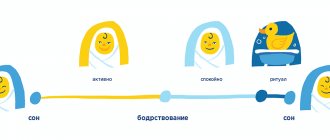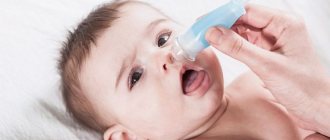The period of wakefulness gradually increases. This time is necessary for the child’s body to adjust and smoothly adapt to changes in the world around him, as well as for parents to recuperate and adapt to changes in life.
Important: the characteristics of the first month of a child’s life are designed for babies who were born on time.
The first way a baby interacts with others is crying . The baby uses it for various reasons - hunger, discomfort in the stomach, discomfort due to wet diapers. A short loud cry is necessary for a child - it stimulates the production of the necessary stress hormone, develops the respiratory and cardiovascular systems, and triggers the activation of certain processes in the cerebral cortex.
Long-term stress has a detrimental effect on the baby and provokes the occurrence of pathologies against the background of depletion of the body’s nervous system.
Emotional sphere
At the age of 1 month, the baby still does not distinguish faces, but is already capable of some emotional reactions. When the parents appear, the child perks up and makes chaotic movements with its arms and legs.
The baby is able to intuitively determine the mother’s mood. A smile indicates that the child is not worried, hurt or worried. Crying expresses a need for communication or physical discomfort.
For normal emotional development, the baby needs to be given attention and offered games, and be sure to hang a musical toy - a mobile - above the crib. It will develop hearing, coordination and will calm the child. In case of a negative reaction, the toy can be offered later.
Caring for a one-month-old baby: daily routine, gymnastics, massage
A routine of alternating sleep, wakefulness and feeding will be established in a healthy child independently in accordance with his physiology. Don't worry if your baby doesn't fall asleep on time, as it might seem. The biorhythms of newborn children are adjusted, so the mother can only try to understand and maintain the rhythm of her child. Having studied the behavior of the child in a state of rest and anxiety, it becomes easy for parents to recognize the “requirements” of their baby.
Feeding
During the first month of life, a healthy child eats at least 8-9 times a day, drinking 60 ml of milk for each meal. Frequently putting a baby to the breast is the main way to stimulate lactation. Mothers who practice breastfeeding have 10–12 feedings per day. At the first sign of the baby's distress, the baby should be given the breast. This method is called feeding on demand, or, otherwise, “free feeding mode”.
Important! Children should be fed only breast milk per month, unless the milk is objectively insufficient, or the pediatrician has recommended supplementing the baby with formula. Also, the child should be offered warm boiled water with a temperature of up to 36 degrees, especially in the hot season.
Dream
The child spends the first month of life sleeping most of the day - about 18-20 hours.
In infants during this period of life, there are five states in which the baby may be:
- deep sleep - the child is relaxed, eyes are closed, breathing slowly and evenly;
- shallow sleep - the child has uneven breathing, noticeably rapid, twitching of the arms and legs is observed, the movement of the eyeballs under the eyelids can be discerned;
- drowsy state - occurs most often while feeding a child or before falling asleep, characterized by half-closed eyelids;
- wakefulness – makes movements with the whole body, is active, wiggles its arms and legs;
- Crying indicates discomfort that the baby feels. May be caused by hunger, fright, or a wet diaper.
Bathing and hygiene procedures
Hygienic procedures for a child per month are carried out daily and include:
- washing the face, eyes, neck;
- washing, changing a diaper;
- care for eyes, nose, ears;
- daily treatment of the umbilical wound;
- combing and removing crusts on the head;
- trimming nails.
Parents choose the baby’s bathing regimen independently, since the condition of the baby’s skin does not require a full daily bath in the bath. It is necessary to carry out daily body rubdowns. In the full sense, it is enough to bathe only 2-3 times a week. To soften the water, you can add herbal decoctions - chamomile and string. The use of solid/liquid soap is also determined individually, based on the sensitivity of the baby's skin.
Walks
Walking is important for the health and full growth of the baby in the first month of life. The child takes his first breath of fresh air upon leaving the maternity hospital. The duration and frequency of daily walks with parents in the first month depends entirely on the time of year and the temperature outside the window.
- The first walks with the baby take only 10-15 minutes, the subsequent duration of being outside gradually increases to half an hour.
- In the warm season, the duration of the walk can reach 1.5-2 hours.
- In the cold season, when the air temperature is below 10 degrees, as well as in the case of strong wind, rain, snowfall, it is not recommended to walk with a child during the first 2 months of life.
On a note! The system for regulating heat exchange in infants of this age is imperfect, so the issue of walking in the cold season must be approached with all seriousness. When there is bad weather outside, it makes sense to take your dressed baby out to the balcony for a few minutes to breathe clean air or let him sleep in a stroller with the window open.
Gymnastics and massage
From about the second or third week of the baby’s life, it is worth starting to give him air baths, as well as hardening and massage.
Gymnastics for a baby at 1 month of age (video instruction): These procedures can be successfully combined in one procedure. To begin with, you can leave the child for a couple of minutes in one light vest or undress and cover with a diaper. At the same moment, begin to do light, barely noticeable stroking with your hands all over the child’s body - arms, tummy, legs. Massage serves not only as a strengthening, but also as a developing, accessible means for the muscles of a one-month-old baby. In subsequent times, it is necessary to carry out the massage a little longer in time - 5-7 minutes. If the baby calmly tolerates your touch and does not show dissatisfaction, you can include massage in your daily restorative procedure.
PS Also read about the development of the baby in the subsequent months of life up to 1 year.
Mental condition
Due to the immaturity of the brain, the child experiences some disorientation. The information received is processed in sleep and wakefulness.
The quality of sleep, receiving the necessary communication with parents and a calm atmosphere in the house have a beneficial effect on the mental development of the baby.
Particular attention should be paid to games and tactile contact, which creates a feeling of security and fulfills the need for communication. This is the key to normal mental development in a newborn.
Important: monotonous, even loud sounds should not cause a 1-month-old child to flinch.
Normal mental development is indicated by the baby’s ability to adjust the position of his body while in the arms of adults, keep his gaze on faces, “coo” and reproduce sounds. Constant conversations with the baby will stimulate the development of the speech apparatus.
Calm, gentle and melodic music, especially classical music, has a beneficial effect on a child’s mental development. Its healing effect is scientifically proven. Just 15-20 minutes a day of music therapy is enough.
The baby's hearing system is already developed enough to introduce games with rattles. They stimulate the processes of memorizing sounds and develop associative thinking.
Examination of a child at 1 month
After discharge from the maternity hospital, the child is visited by a local pediatrician or nurse. They provide patronage for newborns. During the first 4 weeks, the doctor will visit the baby at least 2 times, and the nurse – 4 times.
From the moment the child turns one month old, parents should come with him to the pediatrician's clinic every month for an examination. The doctor will assess the baby’s general condition, check for the presence of basic reflexes, feel the tummy, and listen to the lungs and heart. In addition, the pediatrician weighs the baby, measures his body length, chest and head circumference.
Also, a baby at 1 month should be examined:
- neurologist;
- ophthalmologist;
- orthopedist;
- surgeon.
If additional examinations were not carried out in the maternity hospital, then the child needs to undergo several more important studies - this is an ultrasound of the brain (helps to see the structure of the baby’s brain), ultrasound of the hip joints (necessary to exclude joint dysplasia), as well as ultrasound of the abdominal organs and kidneys (for identifying/excluding the presence of abnormalities in the structure of internal organs at an early stage).
As for vaccinations, the child receives a second vaccination against viral hepatitis B per month (the first vaccination is given to newborns in the first 24 hours after birth).
What should a baby be able to do in the first month?
Each child is unique, but on average, at the age of one month, babies develop an arsenal of skills and abilities :
- holding the head and lifting it from a prone position;
- the ability to listen to sounds and search for their source;
- “humbling” is an emotional response and the foundation for speech development;
- possessing the necessary set of reflexes;
- observation of large, bright objects;
- reaction to sharp sounds - flinching;
- the ability to recognize parents by voice and smell.
On our website there are also articles about the next months of the baby’s life, such as , , , , , , , , , , , months.
Growth and development of a child 1 month of life
In a month the baby grows quickly, eats well and gains weight. Over the last week of life, his body length increased by an average of 1.2 cm and body weight by 250-270 g (based on WHO data). The lower weight limit for male babies at 1 month is 3.6 kg, the upper limit is 6 kg. For girls, the figures are slightly lower: 3.5 kg (lower limit) and 4.6 kg (upper limit). Head circumference increases by about 1.5 cm per month.
Table of child development indicators at 1 month
| Development parameters | Average normal values in the first month of life | |
| girls | boys | |
| Height, cm | 51 – 56 | 55 – 60 |
| Weight, kg | 3,5 – 4,6 | 4,5 – 6 |
| Head circumference, cm | 36 | 37 |
| Chest circumference, cm | 35 | 36 |
If the weight or height of a one-month-old baby differs significantly from the norm, the following factors may be the reasons:
- chosen method of feeding (breastfeeding/artificial feeding);
- presence of problems when feeding the baby (baby’s refusal to breastfeed, allergies, insufficient milk lactation);
- features of the pregnancy and childbirth process (for example, the child was born prematurely);
- the child has a disease that affects height/weight parameters;
- heredity;
- ecology (the mother has bad habits, dangerous environmental factors).
Physical development of a child at 1 month
The first weeks of a child’s life can be called a period of adaptation to independent life outside the mother’s womb. Let us consider the most basic features of the physical development of a child that occur in the baby’s body at the age of one month.
- After birth, the baby's circulatory system is rebuilt. There is an intensive blood supply to the liver and brain.
- The immune system learns to produce specific immunoglobulins to fight infections.
- The kidneys adequately perform their first functions, but even before six months they will be immature, and only after this time will they begin to fully function.
- The infant's respiratory system provides oxygen to the body's tissues and removes carbon dioxide.
- The child’s movements are becoming more and more confident: he can already smoothly bring a pen to his mouth or his face.
- On the baby’s nose, cheeks and forehead, white “grains of sand” – milia, which could be observed in the baby after he was born – disappear.
- Lying on his stomach, the baby turns his head and briefly tries to lift it from the surface, about 45 degrees. Some babies are able to hold their head at a right angle and turn it slightly during the month. The most active infants at this age make attempts to raise their heads while lying on their backs.
- The wedge-shaped and posterior fontanelles on the baby’s head begin to tighten. This is a very slow process and it will take at least a few more weeks to close them. The large fontanel usually closes later; the process of ossification takes about a year.
- During the first month, the baby’s skin continues to peel a little, especially between the toes. She is no longer as dry as she was after birth. If necessary, you can moisturize your baby's skin with special hypoallergenic baby milk or cream labeled 0+.
- An important indicator of a baby’s health is the favorable healing of the umbilical wound. At one month of age it is covered with a crust and does not bleed. In the process of caring for the baby, the mother should monitor the condition of the navel, treat it with hydrogen peroxide or brilliant green, and add a weak solution of potassium permanganate to the bathing water for disinfection.
Nutrition
Previously, there was an opinion that feeding a child should be done hourly, following a certain schedule. Now pediatricians are inclined to believe that it is necessary to feed the baby on demand.
Nature has a mechanism that will prevent the baby from overeating - the amount of food is determined instinctively. This promotes good absorption and digestion.
In addition to mother's milk or formula, you can give your baby a spoonful of water if necessary.
You can calculate how much milk a baby should eat per day (in the case of breastfeeding) in the first 10 days of life by multiplying the baby’s age in days by 80. A single dose will be age multiplied by 10.
These are average figures; in practice, a baby can eat more or less depending on various factors - temperature, well-being.
The average daily dose for children from 10 days of life after birth is about 750-1000 g.
With artificial feeding, there is a risk of overfeeding the baby. To avoid this, it is necessary to feed the child regularly, strictly following the indicated dosages and instructions from the pediatrician.
Daily routine from 0 to month
The daily routine for a baby is completely subordinated to the main natural needs - food and sleep. A well-fed, clean child will sleep as much as his body requires.
It is important for parents to adjust all necessary daily procedures so that they coincide with the child’s biological rhythm. Feeding, bathing, walks, and games must be included in the daily routine.
Care
Hygiene is the basis of a baby’s health. First of all, you should pay attention to the cleanliness of the premises and objects with which the child interacts. The immune system is not yet sufficiently developed, for this reason all pacifiers, toys, and textiles must be kept clean and, if they fall, treated with boiling water or a safe disinfectant .
The room in which the baby is most often located should be well ventilated and the air humidified. Excessive dryness can lead to a number of diseases.
Important: babies lose water very quickly, and dehydration and overheating are deadly.
Personal hygiene
Daily procedures include: regular diaper changes and washing (using wet wipes is appropriate outside the home), rinsing the nose with saline, and air baths. In the first days of life, it is necessary to carefully treat the umbilical wound with brilliant green or hydrogen peroxide.
A few minutes spent naked on a hard, flat surface will ensure healthy skin and normal physiological development of the baby.
Important: Miramistin is a local disinfectant that is safe for the mucous membranes of children. It can be used for daily hygiene procedures.
Trimming nails and cleaning ears is done as needed.
Charger
Physical activity is necessary for a baby from the first days of life. It is better to do gymnastics in the afternoon or morning, about 30 minutes before meals.
To do this, you need to place the baby on a hard surface and alternately bend the arms and legs while lying on your back. In the same position, pull opposite elbows and knees towards each other.
By placing the baby on his stomach, you can place your palms on his feet and stimulate the swimming reflex - the baby will push off from the hand and try to crawl forward. Gymnastics should be completed by pressing the knees to the tummy and a light massage. After feeding, it is appropriate to hold the baby in a column - this position will promote normal digestion of food.
Bathing
This is a pleasant, relaxing procedure that stimulates the mental and physical development of the baby. The optimal water temperature is 36-40 °C. You can enhance the healing effect with the help of herbs - chamomile, string, lovage and bay leaf.
Walks
Dr. Komarovsky recommends taking walks in almost any weather 2-3 times a day . This will strengthen the immune system, and during the waking period the baby will be able to fulfill his needs in the cognitive process, which is necessary for full mental, emotional and social development.
Reflexes of a healthy baby in the 1st month of life
Pediatricians call a reflex the body's response to various stimuli. Parents can independently check how their child is developing in the first month and compare the result with generally established standards. In physically strong and healthy newborn babies, as well as one-month-old infants, the following reflexes are observed:
- grasping - the child clenches his fist tightly when an adult touches his palm;
- sucking - the baby actively sucks on the breast, bottle or pacifier;
- protective – raises and turns the head to the side when laid on the tummy;
- support reflex - if an adult supports the baby, he rests his legs on the changing table;
- crawling reflex - when lying on the stomach, attempts to crawl.
Important! If any reflex is completely or partially absent in the baby, the doctor can conclude that there are disturbances in the functioning of the nervous system and their severity.
Are neurological problems at 1 month a cause for concern?
It often happens that alarming symptoms discovered by a doctor in the first weeks of a child’s life disappear without a trace after some time. This is due to the fact that the child’s nervous system has plasticity and the ability to self-heal. That is why the results of one examination cannot be considered decisive. You can talk about a neurological diagnosis in the first month only after a series of visits to a specialist and brain examinations, including:
- Ultrasound is performed in infants through the fontanelle and helps evaluate the structure of the brain, as well as identify gross problems.
- EEG (electroencephalography) – the process records the electrical activity of the brain. The method is mainly used to diagnose seizures/epilepsy in infants.
- MRI (magnetic resonance imaging) – based on the results of this examination, even small and “deeply hidden” defects can be identified;
- CT (computed tomography) - this method examines in detail the functions and structure of the baby’s central nervous system.
Attention! If it seems to a mother that her child is really lagging behind in psychomotor development, she should immediately, without wasting time, make an appointment for an unscheduled neurological appointment.
Common problems at 4 weeks and how to solve them
There are a number of problems that arise in most babies. They mainly concern the gastrointestinal tract - regurgitation, gas. These problems arise due to the swallowing of air during feeding - the baby cries and presses his legs to his stomach.
In this case, you can give a light massage - make circular movements around the navel clockwise, and also give special medicines - Dill Water, Espumisan, Bobotik or others.
Important: before taking medications, consult a pediatrician. To prevent gas and regurgitation, it is important to properly attach the baby to the breast.
In the case of artificial feeding, it is necessary to carefully study the composition of the formula and select the composition that is most adapted to breast milk. The most common problems with formula feeding are stomach upsets and allergic reactions.
Thrush
The appearance of a small plaque on the oral mucosa can be caused by thrush. To eliminate it, you need to thoroughly treat all toys, objects and bottles with boiling water, and also wipe your mouth with a bandage dipped in a non-concentrated solution of baking soda. In this situation, it is imperative to contact a specialist and follow his recommendations.
Irritation on the butt
Babies often suffer from redness and rashes due to the use of unsuitable diapers. In this situation, hygiene products must be changed to others, and the baby must be left without clothes longer. Ointments can significantly alleviate the child’s condition - Bepanten, Sudocrem and other products that are designed for children and promote skin healing.
Important: the delicate skin of a baby needs careful care; for this purpose you can use natural vegetable oils adapted for children, creams and lotions marked “0+”.










